| Revision as of 13:12, 17 September 2012 editMogism (talk | contribs)Extended confirmed users, Pending changes reviewers185,177 editsm Typo fixing and cleanup, typos fixed: a Orientalist → an Orientalist using AWB (8323)← Previous edit | Revision as of 18:47, 20 September 2012 edit undoJarble (talk | contribs)Autopatrolled, Extended confirmed users149,707 edits wikifyingNext edit → | ||
| Line 122: | Line 122: | ||
| In his novel '']'', ] used ancient ] in North Africa as a ] to ancient ]. He portrayed its culture as morally corrupting and suffused with dangerously alluring eroticism. This novel proved hugely influential on later portrayals of ancient ] cultures. | In his novel '']'', ] used ancient ] in North Africa as a ] to ancient ]. He portrayed its culture as morally corrupting and suffused with dangerously alluring eroticism. This novel proved hugely influential on later portrayals of ancient ] cultures. | ||
| The use of the Orient as an exotic backdrop continued in the movies, for instance, those featuring ]. Later the rich Arab in robes became a more popular theme, especially during the oil crisis of the 1970s. In the 1990s the Arab terrorist became a common villain figure in Western movies. | The use of the Orient as an exotic backdrop continued in the movies, for instance, those featuring ]. Later the rich Arab in robes became a more popular theme, especially during the oil crisis of the 1970s. In the 1990s the ] became a common villain figure in Western movies. | ||
| ===Examples=== | ===Examples=== | ||
Revision as of 18:47, 20 September 2012
For the book by Edward Said, see Orientalism (book). For the discipline that studies the Orient, see Oriental studies.| The article's lead section may need to be rewritten. Please help improve the lead and read the lead layout guide. (April 2011) (Learn how and when to remove this message) |

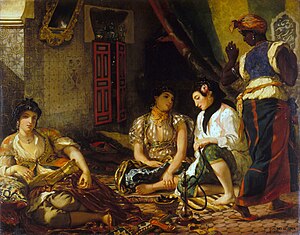




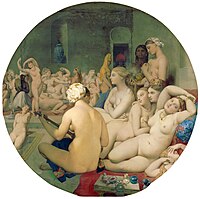


Orientalism is a term used by art historians, literary and cultural studies scholars for the imitation or depiction of aspects of Middle Eastern, and East Asian cultures (Eastern cultures) by American and European writers, designers and artists. In particular, Orientalist painting, depicting more specifically "the Middle East", was one of the many specialisms of 19th century Academic art.
Since the publication of Edward Said's Orientalism, the term has tended to acquire acquired a negative connotation, and in much academic discourse become shorthand for Western feelings of superiority over, and overlooking of the views of, Asian and North African cultures.
Meaning of the term
"Orientalism" refers to the Orient or East, in contrast to the Occident or West, and often, as seen by the West.
"Orientalism" is widely used in art, to refer to the works of the many Western 19th century artists, who specialized in "Oriental" subjects, often drawing on their travels to Western Asia. Artists as well as scholars were already described as "Orientalists" in the 19th century, especially in France, where the term, with a rather dismissive sense, was largely popularized by the critic Jules-Antoine Castagnary. Such disdain did not prevent the Société des Peintres Orientalistes ("Society of Orientalist Painters") being founded in 1893, with Jean-Léon Gérôme as honorary president; the word was less often used as a term for artists in 19th century England.
Since the 18th century, "Orientalist" has been the traditional term for a scholar of Oriental studies; however the use in English of "Orientalism" to describe the academic subject of "Oriental studies" is rare; the Oxford English Dictionary cites only one such usage, by Lord Byron in 1812. The academic discipline of Oriental studies is now more often called Asian studies.
In 1978, the Palestinian-American scholar Edward Said published his influential and controversial book, Orientalism, which "would forever redefine" the word; he used the term to describe a pervasive Western tradition, both academic and artistic, of prejudiced outsider interpretations of the East, shaped by the attitudes of European imperialism in the 18th and 19th centuries. Said was critical of both this scholarly tradition and of some modern scholars, particularly Bernard Lewis. Said was mainly concerned with literature in the widest sense, especially French literature, and did not cover visual art and Orientalist painting, though others, notably Linda Nochlin, have tried to extend his analysis to art, "with uneven results". Said's work became one of the foundational texts of Postcolonialism or Postcolonial studies.
Orientalizing styles in Europe
Further information: Orientalism in early modern FranceThe Moresque style of Renaissance ornament is a European adaptation of the Islamic arabesque that began in the late 15th century and was to be used in some types of work, such as bookbinding, until almost the present day. Early architectural use of motifs lifted from the Indian subcontinent has sometimes been called "Hindoo style". One of the earliest examples is the façade of Guildhall, London (1788–1789). The style gained momentum in the west with the publication of views of India by William Hodges, and William and Thomas Daniell from about 1795. Examples of "Hindoo" architecture are Sezincote House (c. 1805) in Gloucestershire, built for a nabob returned from Bengal, and the Royal Pavilion in Brighton.
Turquerie, which began as early as the late 15th century, continued until at least the 18th century, and included both the use of "Turkish" styles in the decorative arts, the adoption of Turkish costume at times, and interest in art depicting the Ottoman Empire itself. Venice, the traditional trading partner of the Ottomans, was the earliest centre, with France becoming more prominent in the 18th century.
Chinoiserie is the catch-all term for the fashion for Chinese themes in decoration in Western Europe, beginning in the late 17th century and peaking in waves, especially Rococo Chinoiserie, ca. 1740–1770. From the Renaissance to the 18th century, Western designers attempted to imitate the technical sophistication of Chinese ceramics with only partial success. Early hints of Chinoiserie appeared in the 17th century in nations with active East India companies: England (the British East India Company), Denmark (the Danish East India Company), the Netherlands (the Dutch East India Company) and France (the French East India Company). Tin-glazed pottery made at Delft and other Dutch towns adopted genuine blue-and-white Ming decoration from the early 17th century. Early ceramic wares made at Meissen and other centers of true porcelain imitated Chinese shapes for dishes, vases and teawares (see Chinese export porcelain).
Pleasure pavilions in "Chinese taste" appeared in the formal parterres of late Baroque and Rococo German palaces, and in tile panels at Aranjuez near Madrid. Thomas Chippendale's mahogany tea tables and china cabinets, especially, were embellished with fretwork glazing and railings, ca 1753–70. Sober homages to early Xing scholars' furnishings were also naturalized, as the tang evolved into a mid-Georgian side table and squared slat-back armchairs that suited English gentlemen as well as Chinese scholars. Not every adaptation of Chinese design principles falls within mainstream "chinoiserie." Chinoiserie media included imitations of lacquer and painted tin (tôle) ware that imitated japanning, early painted wallpapers in sheets, and ceramic figurines and table ornaments. Small pagodas appeared on chimneypieces and full-sized ones in gardens. Kew has a magnificent garden pagoda designed by Sir William Chambers. The Wilhelma (1846) in Stuttgart is an example of Moorish Revival architecture. Leighton House, built for the artist Lord Leighton, has a conventional facade but elaborate Arab-style interiors, including original Islamic tiles and other elements as well as Victorian Orientalizing work.
After 1860, Japonisme, sparked by the importing of Japanese woodblock prints, became an important influence in the western arts. In particular, many modern French artists such as Monet and Degas were influenced by the Japanese style. Mary Cassatt, an American artist who worked in France, used elements of combined patterns, flat planes and shifting perspective of Japanese prints in her own images. The paintings of James McNeill Whistler and his "Peacock Room" demonstrated how he used aspects of Japanese tradition and are some of the finest works of the genre. California architects Greene and Greene were inspired by Japanese elements in their design of the Gamble House and other buildings.
In architecture, Egyptian revival architecture was popular mostly in the early and mid-19th century, and Indo-Saracenic Revival architecture or Moorish Revival architecture, covering a variety of general Islamic or Indian features, in the later part of the century; "Saracenic" referred to styles from Arabic-speaking areas. Both were sometimes used in the Orient itself by colonial governments.
Orientalist art
Pre-19th century
Depictions of Islamic "Moors" and "Turks" (imprecisely named Muslim groups of North Africa and West Asia) can be found in Medieval, Renaissance, and Baroque art. In Biblical scenes in Early Netherlandish painting, secondary figures, especially Romans, were given exotic costumes that distantly reflected the clothes of the Near East. The Three Magi in Nativity scenes were an especial focus for this. Renaissance Venice had a phase of particular interest in depictions of the Ottoman Empire in painting and prints. Gentile Bellini, who travelled to Constantinople and painted the Sultan, and Vittore Carpaccio were the leading painters. By then the depictions were more accurate, with men typically dressed all in white. The depiction of Oriental carpets in Renaissance painting sometimes draws from Orientalist interest, but more often just reflects the prestige these expensive objects had in the period.
Jean-Étienne Liotard (1702–1789) visited Istanbul and painted numerous pastels of Turkish domestic scenes; he also continued to wear Turkish dress for much of the time when back in Europe. The ambitious Scottish 18th century artist Gavin Hamilton found a solution to the problem of using modern dress, considered unheroic and inelegant, in history painting by using Middle Eastern settings with Europeans wearing local costume, as travellers were advised to do. His huge James Dawkins and Robert Wood Discovering the Ruins of Palmyra (1758, now Edinburgh) elevates tourism to the heroic, with the two travellers wearing what look very like togas. Many travellers had themselves painted in exotic Eastern dress on their return, including Lord Byron, as did many who had never left Europe, including Madame de Pompadour. Byron's poetry was highly influential in introducing Europe to the heady cocktail of Romanticism in exotic Oriental settings which was to dominate 19th century Oriental art.
French Orientalism
French Orientalist painting was transformed by Napoleon's ultimately unsuccessful invasion of Egypt and Syria in 1798-1801, which stimulated great public interest in Egyptology, and was also recorded in subsequent years by Napoleon's court painters, especially Baron Gros, although the Middle Eastern campaign was not one on which he accompanied the army. Two of his most successful paintings, Bonaparte Visiting the Plague Victims of Jaffa (1804) and Battle of Abukir (1806) focus on the Emperor, as he was by then, but include many Egyptian figures, as does the less effective Napoleon at the Battle of the Pyramids (1810). Girodet's La Révolte du Caire (1810) was another large and prominent example. A well-illustrated Description de l’Égypte was published by the French Government in twenty volumes between 1809 and 1828, concentrating on antiquities.
Eugène Delacroix's first great success, The Massacre at Chios (1824) was painted before he visited the Greece or the East, and followed his friend Théodore Géricault's The Raft of the Medusa in showing a recent incident in distant parts that had aroused public opinion. Greece was still fighting for independence from the Ottomans, and was effectively as exotic as the more Near Eastern parts of the empire. Delacroix followed up with Greece on the Ruins of Missolonghi (1827), commemorating a siege of the previous year, and the Death of Sardanapalus, inspired by Lord Byron, which although set in antiquity has been credited with beginning the mixture of sex, violence, lassitude and exoticism which runs through much French Orientalist painting. In 1832 Delacroix finally visited what is now Algeria, recently conquered by the French, and Morocco, as part of a diplomatic mission to the Sultan of Morocco. He was greatly struck by what he saw, comparing the North African way of life to that of the Ancient Romans, and continued to paint subjects from his trip on his return to France. Like many later Orientalist painters, he was frustrated by the difficulty of sketching subjects including women, and many of his scenes featured Jews or warriors on horses. However he was apparently able to get into the women's' quarters or harem of a house to sketch what became The Women of Algiers; few later harem scenes had this claim to authenticity.
When Ingres, the director of the French Académie de peinture, painted a highly colored vision of a Turkish bath (illustration, right), he made his eroticized Orient publicly acceptable by his diffuse generalizing of the female forms (who might all have been the same model.) More open sensuality was seen as acceptable in the exotic Orient. This imagery persisted in art into the early 20th century, as evidenced in Matisse's orientalist semi-nudes from his Nice period, and his use of Oriental costumes and patterns. Ingres' pupil Théodore Chassériau (1819–1856) had already achieved success with his nude The Toilette of Esther (1841, Louvre) and equestrian portrait of Ali-Ben-Hamet, Caliph of Constantine and Chief of the Haractas, Followed by his Escort (1846) before he first visited the East, but in later decades the steamship made travel much easier and increasing numbers of artists traveled to the Middle East and beyond, painting a wide range of Oriental scenes.
In many of these works, they portrayed the Orient as exotic, colorful and sensual, not to say stereotyped. Such works typically concentrated on Oriental Islamic, Hebraic, and other Semitic cultures, as those were the ones visited by artists as France became more engaged in North Africa. French artists such as Eugène Delacroix, Jean-Léon Gérôme and Jean Auguste Dominique Ingres painted many works depicting Islamic culture, often including lounging odalisques. They stressed both lassitude and visual spectacle. Other scenes, especially in genre painting, have been seen as either closely comparable to their equivalents set in modern-day or historical Europe, or as also reflecting an Orientalist mind-set in the Saidian sense of the term. Gérôme was the precursor, and often the master, of a number of French painters in the later part of the century whose works were often frankly salacious, frequently featuring scenes in harems, public baths and slave auctions (the last two also available with classical decor), and responsible, with others, for "the equation of Orientalism with the nude in pornographic mode".
British Orientalism

Though British political interest in the territories of the unravelling Ottoman Empire was as intense as in France, it was mostly more discreetly exercised. The origins of British Orientalist 19th century painting owe more to religion than military conquest or the search for plausible locations for naked females. The leading British genre painter, Sir David Wilkie was 55 when he travelled to Istanbul and Jerusalem in 1840, dying off Gibraltar during the return voyage. Though not noted as a religious painter, Wilkie made the trip with a Protestant agenda to reform religious painting, as he believed that: "a Martin Luther in painting is as much called for as in theology, to sweep away the abuses by which our divine pursuit is encumbered", by which he meant traditional Christian iconography. He hoped to find more authentic settings and decor for Biblical subjects at their original location, though his death prevented more than studies being made. Other artists including the Pre-Raphaelite William Holman Hunt and David Roberts had similar motivations, giving an emphasis on realism in British Orientalist art from the start. The French artist James Tissot also used contemporary Middle Eastern landscape and decor for Biblical subjects, with little attempt at historicising costumes or other fittings.
William Holman Hunt produced a number of major paintings of Biblical subjects drawing on his Middle Eastern travels, improvising variants of contemporary Arab costume and furnishings to avoid specifically Islamic styles, and also some landscapes and genre subjects. The biblical subjects included The Scapegoat (1856), The Finding of the Saviour in the Temple (1860), and The Shadow of Death (1871). The Miracle of the Holy Fire (1899) was intended as a picturesque satire on the local Eastern Christians, of whom, like most English visitors, Hunt took a very dim view. His A Street Scene in Cairo; The Lantern-Maker's Courtship (1854–61) is a rare contemporary narrative scene, as the young man feels his fiancé's face, which he is not allowed to see, through her veil, as an Westerner in the background beats his way up the street with his stick. This a rare intrusion of a clearly contemporary figure into an Orientalist scene; mostly they claim the picturesqueness of the historical painting so popular at the time, without the trouble of researching authentic costumes and settings.
When Gérôme exhibited For Sale; Slaves at Cairo at the Royal Academy in London in 1871, it was "widely found offensive", perhaps partly because the British liked to think they had successfully suppressed the slave trade in Egypt, also for cruelty and "representing fleshiness for its own sake". But Rana Kabbani believes that "French Orientalist painting, as exemplified by the works of Gérôme, may appear more sensual, gaudy, gory and sexually explicit than its British counterpart, but this is a difference of style not substance ... Similar strains of fascination and repulsion convulsed their artists" Nonetheless, nudity and violence are more evident in British paintings set in the ancient world, and "the iconography of the odalisque ... the Oriental sex slave whose image is offered up to the viewer as freely as she herself supposedly was to her master - is almost entirely French in origin", though taken up with enthusiasm by Italian and other painters.
John Frederick Lewis, who lived for several years in a traditional mansion in Cairo, painted highly detailed works showing both realistic genre scenes of Middle Eastern life and more idealized scenes in upper class Egyptian interiors with no traces of Western cultural influence yet apparent. His very careful and loving representation of Islamic architecture, furnishings, screens, and costumes set new standards of realism, which influenced other artists, including Gérôme in his later works. He "never painted a nude", and his wife modelled for several of his harem scenes, which, with the rare examples by the classicist painter Lord Leighton, imagine "the harem as a place of almost English domesticity, ... ... women's fully clothed respectability suggests a moral healthiness to go with their natural good looks".
English and French harems
-
 Ingres, Odalisque and slave-girl, 1842
Ingres, Odalisque and slave-girl, 1842
-
 Fernand Cormon, Murder in the Seraglio, 1872
Fernand Cormon, Murder in the Seraglio, 1872
-
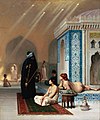 Jean-Léon Gérôme (1824–1904), Pool in a Harem, c. 1876
Jean-Léon Gérôme (1824–1904), Pool in a Harem, c. 1876
-
 John Frederick Lewis, The Reception, 1873
John Frederick Lewis, The Reception, 1873
-
Frederick Goodall, A New Light in the Harem, 1884
Other artists concentrated on landscape painting, often of desert scenes, including Richard Dadd and Edward Lear. David Roberts (1796–1864) produced architectural and landscape views, many of antiquities, and published very successful books of lithographs from them.
Elsewhere
Russian Orientalist art was largely concerned with the areas of Central Asia that Russia was conquering during the century, and also in historical painting with the Mongols who had dominated Russia for much of the Middle Ages, who were rarely shown in a good light. Nationalist historical painting in Central Europe and the Balkans dwelt on Turkish oppression, with battle scenes and maidens about to be raped.
The Saidian analysis has not prevented a strong revival of interest in, and collecting of, 19th century Orientalist works since the 1970s, the latter in large part led by Middle Eastern buyers,
Orientalist artists
- Gustave Boulanger (1824–88)
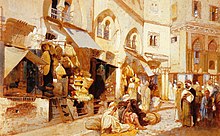
Algerian shops, by Louis Comfort Tiffany 
Samarkand, by Richard-Karl Karlovitch Zommer 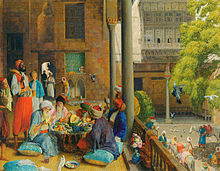
The midday meal, Cairo, by John Frederick Lewis - Eduard Charlemont (1848-1906)
- Théodore Chassériau (1819–1856)
- Richard Dadd (1817–1886)
- Eugène Delacroix (1798–1863)
- Ludwig Deutsch (1855–1935)
- Alphonse Étienne Dinet
- Edmund Dulac
- Eugène Fromentin (1820–1876)
- Jean-Léon Gérôme (1824–1904)
- Gustave Achille Guillaumet (1840-1887)
- William Holman Hunt (1827–1910)
- Jean Auguste Dominique Ingres (1780–1867)
- Edward Lear (1812–1888)
- Frederic Leighton (1830–1896)
- John Frederick Lewis (1805–1876)
- Jean-Étienne Liotard (1702–1789)
- Edwin Longsden Long, a specialist in Ancient Egyptian scenes
- Alberto Pasini (1826–1899)
- Théodore Ralli (1852–1909)
- David Roberts (painter) (1796–1864)
- Alexandre Roubtzoff (1884–1949)

- Giulio Rosati (1858–1917)
- James Tissot (1836–1902)
- David Wilkie (1785–1841)
- Jean-Baptiste van Mour (1671–1731)
- Ecem Kafadar (1885–1940)
- Edwin Lord Weeks (1849–1903)
- Adolf Schreyer (1828–1899)
Literature and music
Authors and composers are not commonly referred to as "Orientalist" in the way that artists are, and relatively few specialized in Oriental topics or styles, or are even best known for their works including them. But many major figures, from Mozart to Flaubert, have produced significant works with Oriental subjects or treatments. For example, Verdi's opera Aida (1871) is set in Egypt as portrayed through the content and the visual spectacle. "Aida" depicts a militaristic Egypt's tyranny over Ethiopia.
In music, Orientalism may be applied to styles occurring in different periods, such as the alla Turca, used by multiple composers including Mozart and Beethoven. Orientalism is also traceable in music that is considered to have effects of exoticism, including the japonisme in Claude Debussy's piano music all the way to the sitar being used in recordings by The Beatles.
In his novel Salammbô, Gustave Flaubert used ancient Carthage in North Africa as a foil to ancient Rome. He portrayed its culture as morally corrupting and suffused with dangerously alluring eroticism. This novel proved hugely influential on later portrayals of ancient Semitic cultures.
The use of the Orient as an exotic backdrop continued in the movies, for instance, those featuring Rudolph Valentino. Later the rich Arab in robes became a more popular theme, especially during the oil crisis of the 1970s. In the 1990s the Arab terrorist became a common villain figure in Western movies.
Examples
| This section does not cite any sources. Please help improve this section by adding citations to reliable sources. Unsourced material may be challenged and removed. (August 2010) (Learn how and when to remove this message) |
| This section may contain excessive or irrelevant examples. Please help improve the article by adding descriptive text and removing less pertinent examples. (June 2010) |
Literature
- The Travels of Marco Polo, 13th century
- Travels of Sir John Mandeville, 14th century invented account of travels.
- Christopher Marlowe, Tamburlaine, 1588/89
- John Dryden, Aureng-zebe (1675), a heroic drama in theory based on the life of the reigning Mughal Emperor, Aurangzeb
- Montesquieu — Persian Letters (Lettres persanes) (1721)
- William Thomas Beckford — Vathek (1786)
- Robert Southey — Thalaba the Destroyer (1801)
- Robert Southey — Curse of Kehama (1810)
- Lord Byron — The Bride of Abydos, The Giaour, Don Juan and other works
- Samuel Taylor Coleridge — Kubla Khan (published 1816)
- Thomas Moore — Lalla-Rookh (published 1817)
- Johann Wolfgang von Goethe — Westöstlicher Diwan (1819)
- Ralph Waldo Emerson — poem Indian Superstition (1821)
- Edgar Allan Poe — Tamerlane (1827), Al Aaraaf (1829), and Israfel (1831)
- Victor Hugo — Les Orientales (1829)
- Gustave Flaubert — Salammbô (1862)
- Eça de Queiroz — The Relic (A Relíquia) (1887) and The Mandarin (O Mandarim) (1889)
- Anatole France — Thaïs (1890)
- Edward FitzGerald - "translation" or adaptation of the Persian Rubaiyat of Omar Khayyam (1859)
- Pierre Loti (1850–1923) - highly popular French writer, mostly on his Oriental travels & novels set as far away as Japan and Tahiti
- Richard Francis Burton — translation of The Book of One Thousand and One Nights (1885–1888)
- Leo Tolstoy — Hadji Murat (1912)
- Victor Segalen — René Leys (1922)
- Herman Hesse — Siddhartha (1922)
- André Malraux — Man's Fate (1934) (La Condition humaine, 1933)
- Marguerite Yourcenar's Nouvelles Orientales (1938)
Opera, ballets, musicals


- Antonio Lucio Vivaldi — Juditha triumphans (1716)
- Georg Friedrich Händel — Tamerlano (1724) and Serse (1738)
- Jean-Philippe Rameau — Les Indes Galantes (1735–1736)
- Wolfgang Amadeus Mozart — Die Entführung aus dem Serail (1782)
- Gioachino Rossini — Semiramide (1823)
- Giuseppe Verdi — Nabucco (1842)
- Jacques Offenbach — Ba-ta-clan (1855)
- Georges Bizet — Les Pêcheurs de Perles (1863)
- Giuseppe Verdi — Aida (1871)
- Emmanuel Chabrier — Fisch-Ton-Kan (1875)
- César Cui — The Mandarin's Son (1878)
- Gilbert and Sullivan — The Mikado (1885)
- Alexander Borodin — Prince Igor (1890)
- Sidney Jones — The Geisha (1896)
- Sidney Jones — San Toy (1899)
- Pietro Mascagni — Iris (1899)
- Howard Talbot — A Chinese Honeymoon (1896)
- Giacomo Puccini — Madama Butterfly (1904)
- Richard Strauss — Salome, opera in one act based on Wilde's play (1905)
- Giacomo Puccini — Turandot (1926)
- Franz Lehár - The Land of Smiles (1929)
- Sigmund Romberg, Oscar Hammerstein II & Otto Harbach — The Desert Song (1926) and film (1929)
- Richard Strauss — Die ägyptische Helena, opera with libretto by Hugo von Hofmannsthal (1929)
Orchestral works
- Mily Balakirev — Tamara.
- Alexander Borodin — In the Steppes of Central Asia; "Polovetsian Dances" from Prince Igor.
- Mikhail Ippolitov-Ivanov — Caucasian Sketches.
- Modest Mussorgsky — "Dance of the Persian Slaves" from Khovanshchina.
- Nikolai Rimsky-Korsakov — Antar; Scheherezade.
- Gustav Mahler - Das Lied von der Erde
Shorter musical pieces
- Mily Balakirev — Islamey
- Ludwig van Beethoven—Turkish March from The Ruins of Athens, opus 113 (1811)
- Johann Joseph Fux - partita Turcaria, inspired by the 1683 Siege of Vienna by the Turks.
- Alexander Glazunov - 5 Novelettes for String Quartet, Op 15
- Albert Ketèlbey — In a Persian Market (1920), In a Chinese Temple Garden (1925), and In the Mystic Land of Egypt (1931)
- Wolfgang Amadeus Mozart—Rondo alla turca from Piano Sonata No.11 (K.331)
- Sergei Rachmaninoff — Oriental Sketch (1917)
Theatre

- Tobias Bamberg's magic stage act as "Okito" (Germany, 1893 – United States, 1908)
- Oscar Wilde's Salomé (1893, first performed in Paris 1896)
- Alexander's mentalism stage act (United States, c. 1890s–1910s)
- William Ellsworth Robinson's, magic stage act as "Chung Ling Soo" (United States, 1900–1918)
Photography
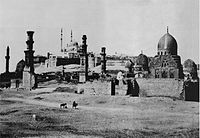
Pulp magazines
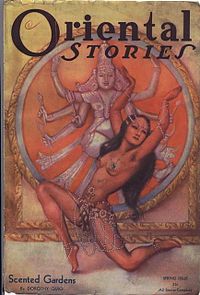
- Oriental Stories: A pulp magazine published 1930–34 by Chicago based Popular Fiction specialising in Orientalist fiction. The title was later changed to The Magic Carpet Magazine.
Films
- Intolerance (1916)
- Broken Blossoms (1919)
- The Sheik (1921)
- The Lives of a Bengal Lancer (1935)
- The Thief of Bagdad (1940)
- My Geisha (1962)
- Indiana Jones and the Temple of Doom (1984)
- Sex and the City 2 (2010)
Comics
- The Adventures of Tintin (1929–1983)
- The Upside Down Circle by Don Gilbert (1990).
- Dragon and Tiger (2008)
- Habibi (2011)

Eastern views of the West
Much of Said's criticism of Western "Orientalism" is based on particularizing trends also present in Asian works by Indian, Chinese and Japanese writers and artists, in their views of Western culture and tradition. The term Occidentalism has sometimes been used to refer to negative or stereotypical views of the Western world found in Eastern societies.
In the late 20th century many Western cultural themes and images began appearing in Asian art and culture, especially in Japan. English words and phrases are prominent in Japanese advertising and popular culture, and many Japanese anime are written around characters, settings, themes, and mythological figures derived from various Western cultural traditions.
See also
Notes
- Tromans, 6
- from the Latin oriens; Oxford English Dictionary
- Tromans, 20
- Harding, 74
- Tromans, 19
- Tromans, 24
- Tromans, 6, 11 (quoted), 23-25
- The subject of Ives
- King and Sylvester, throughout
- Christine Riding, Travellers and Sitters: The Orientalist Portrait, in Tromans, 48-75
- Harding, 69-70
- Nochlin, 294-296; Tromans, 128
- Harding, 81
- Tromans, 135
- Tromans, 136
- Tromans, 14 (quoted), 162-165
- Nochlin, 289, disputing Rosenthal assertion, and insisting that "there must be some attempt to clarify whose reality we are talking about".
- Tromans, 16-17 and see index
- Tromans, 135-136
- Tromans, 43
- Tromans, 135
- Tromans, quote 135; 134 on his wife; generally: 22-32, 80-85, 130-135, and see index
- Tromans, 135
- Tromans, 102-125, covers landscape
- Tromans, 7, 21
- Beard and Gloag 2005, 128
- Beard and Gloag 2005, 129
- Beard and Gloag 2005, 129
- "Description of contents of album "Alla Turca"". Atmaclassique.com. Retrieved 2012-03-27.
- Daily Telegraph Review, Guardian review
References
- Beard, David and Kenneth Gloag. 2005. Musicology: The Key Concepts. New York: Routledge.
- Harding, James, Artistes Pompiers: French Academic Art in the 19th Century, 1979, Academy Editions, ISBN 856704512
- C F Ives, "The Great Wave: The Influence of Japanese Woodcuts on French Prints", 1974, The Metropolitan Museum of Art, ISBN 0-87099-098-5
- King, Donald and Sylvester, David eds. The Eastern Carpet in the Western World, From the 15th to the 17th century, Arts Council of Great Britain, London, 1983, ISBN 0-7287-0362-9
- Mack, Rosamond E. Bazaar to Piazza: Islamic Trade and Italian Art, 1300-1600, University of California Press, 2001 ISBN 0-520-22131-1
- Meagher, Jennifer. Orientalism in Nineteenth-Century Art. In Heilbrunn Timeline of Art History. New York: The Metropolitan Museum of Art, 2000–. online, accessed April 11, 2011
- Nochlin, Linda, The Imaginary Orient, 1983, page numbers from reprint in The nineteenth-century visual culture reader, google books, a reaction to Rosenthal's exhibition and book.
- Said, Edward W. Orientalism. New York: Pantheon Books, 1978 ISBN 0-394-74067-X).
- Tromans, Nicholas, and others, The Lure of the East, British Orientalist Painting, 2008, Tate Publishing, ISBN 978-1-85437-733-3
Further reading
- Springer, Simon. 2011, Culture of violence or violent Orientalism? Neoliberalisation and imagining the 'savage other' in post-transitional Cambodia. Transactions of the Institute of British Geographers 34 (3), 305-319.
- Weir, David. American Orient: Imagining the East From the Colonial Era Through the Twentieth Century (University of Massachusetts Press; 2011) 304 pages;
Mainly on art
- Jean-Marc Aractingi,"Peintres Orientalistes" Editions Vues d'Orient,Paris,2003
- Peltre, Christine. Orientalism in Art. New York: Abbeville Publishing Group (Abbeville Press, Inc.), 1998 (ISBN 0-7892-0459-2).
- Rosenthal, Donald A. Orientalism: The Near East in French Painting, 1800–1880. Rochester, N.Y.: Memorial Art Gallery of the University of Rochester, 1982.
- Stevens, Mary Anne, ed. The Orientalists: Delacroix to Matisse: European Painters in North Africa and the Near East. Exhibition catalogue. London: Royal Academy of Arts, 1984
- Benjamin, Roger Orientalist Aesthetics, Art, Colonialism and French North Africa: 1880-1930, U. of California Press, 2003
Literature
- Halliday, Fred. "'Orientalism' and Its Critics", British Journal of Middle Eastern Studies, Vol. 20, No. 2. (1993), pp. 145–163.
- Irwin, Robert. For lust of knowing: The Orientalists and their enemies. London: Penguin/Allen Lane, 2006 (ISBN 0-7139-9415-0)
- Kabbani, Rana. Imperial Fictions: Europe's Myths of Orient. London: Pandora Press, 1994 (ISBN 0-04-440911-7).
- Klein, Christina. Cold War Orientalism: Asia in the Middlebrow Imagination, 1945–1961. Berkeley: University of California Press, 2003 (ISBN 0-520-22469-8; paperback, ISBN 0-520-23230-5).
- Knight, Nathaniel. "Grigor'ev in Orenburg, 1851–1862: Russian Orientalism in the Service of Empire?", Slavic Review, Vol. 59, No. 1. (Spring, 2000), pp. 74–100.
- Kontje, Todd. German Orientalisms. Ann Arbor, MI: University of Michigan Press, 2004 (ISBN 0-472-11392-5).
- Little, Douglas. American Orientalism: The United States and the Middle East Since 1945. (2nd ed. 2002 ISBN 1-86064-889-4).
- López-Calvo, Ignacio, ed. Alternative Orientalisms in Latin America and Beyond. Newcastle, England: Cambridge Scholars Publishing, 2007 (ISBN 1-84718-143-0)
- López-Calvo, Ignacio, ed. One World Periphery Reads the Other: Knowing the "Oriental" in the Americas and the Iberian Peninsula. Newcastle, England: Cambridge Scholars Publishing, 2009 (ISBN 1-4438-1657-4)
- López-Calvo, Ignacio, ed. Peripheral Transmodernities: South-to-South Dialogues between the Luso-Hispanic World and "the Orient." Newcastle, England: Cambridge Scholars Publishing, 2012. (ISBN 1-4438-3714-8)
- Lowe, Lisa. Critical Terrains: French and British Orientalisms. Ithaca: Cornell University Press, 1992 (ISBN 978-0-8014-8195-6).
- Macfie, Alexander Lyon. Orientalism. White Plains, NY: Longman, 2002 (ISBN 0-582-42386-4).
- MacKenzie, John. Orientalism: History, theory and the arts. Manchester: Manchester University Press, 1995 (ISBN 0-7190-4578-9), google books.
- Murti, Kamakshi P. India: The Seductive and Seduced "Other" of German Orientalism. Westport, CT: Greenwood Press, 2001 (ISBN 0-313-30857-8).
- Noble dreams, wicked pleasures: Orientalism in America, 1870–1930 by Holly Edwards (Editor). Princeton: Princeton University Press, 2000 (ISBN 0-691-05004-X).
- Oueijan, Naji. The Progress of an Image: The East in English Literature. New York: Peter Lang Publishers, 1996.
- Schlicht, Alfred, "Die Araber und Europa", Stuttgart, Kohlhammer, 2008
External links
- The Orientalist Painters
- The Orientalists' Art Works Gallery
- Orientalism 25 Years Later, by Said in 2003
- "China in Western Thought and Culture" Dictionary of the History of Ideas, etext, University of Virginia
- Brian Whitaker, "Distorting Desire", review, Joseph Abbad, Desiring Arabs, Chicago: University of Chicago Press, 2007, from Al-Bab.com, on Reflections of a Renegade blog site
- Martin Kramer, "Edward Said's Splash", from his book, Ivory Towers on Sand: The Failure of Middle Eastern Studies in America, Washington: The Washington Institute for Near East Policy, 2001, pp. 27–43.
- Andre Gingrich, "Frontier Orientalism", Camp Catatonia blog
- Orientalism in the "History of Art", All Art
- Orientalist art and photography, London Times Online
- "Alexander Roubtzoff" (1884–1949), Artistic Association Alexander Roubtzoff
- "Edward Said and the Production of Knowledge", CitizenTrack
- Articles & Analysis on Orientalists' Art Works